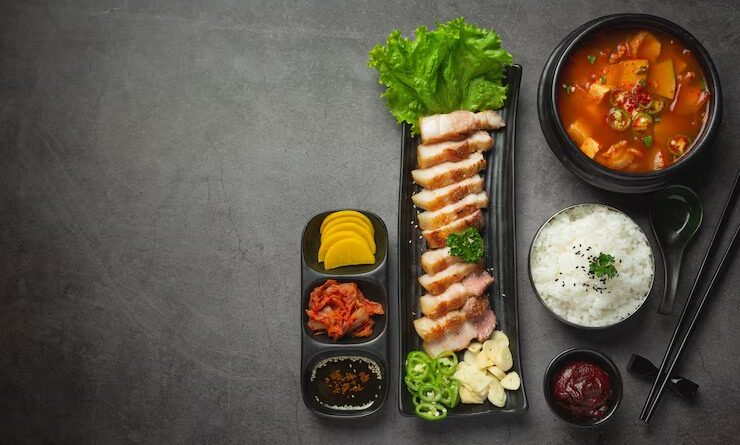A Delicious Journey: Exploring the Best Foods of South Korea
South Korea’s vibrant culture extends far beyond K-pop and technological advancements. Korean cuisine is a hidden gem, offering a unique blend of bold flavors, fresh ingredients, and beautiful presentation. From the fiery kick of kimchi to the comforting warmth of stews, Korean food is an exciting adventure for your taste buds.
This blog will be your guide on this delicious journey, highlighting some of the most popular and delectable dishes South Korea has to offer. So, grab your chopsticks and get ready to dig in!
Kimchi: The National Staple
No exploration of Korean food is complete without mentioning kimchi. This fermented vegetable dish, most commonly made with napa cabbage, is a national staple. Kimchi’s unique flavor profile comes from the fermentation process, which creates a complex interplay of spicy, sour, and savory notes. Kimchi is incredibly versatile, enjoyed on its own, as a side dish with most meals, or even incorporated into other dishes like kimchi jjigae (kimchi stew) and kimchi fried rice.
Bibimbap: A Colorful Bowl of Goodness
Bibimbap translates to “mixed rice,” and this dish perfectly captures its essence. A colorful and visually stunning bowl, bibimbap features fluffy white rice topped with an assortment of seasoned vegetables, thinly sliced meat (usually beef or pork), a fried egg, and of course, a generous portion of kimchi. The beauty lies in the customizability. Diners mix everything together, creating a symphony of textures and flavors in every bite.
Korean BBQ: A Sizzling Feast
Korean barbecue, also known as KBBQ, is a social dining experience that’s both fun and delicious. Thinly sliced meats, like bulgogi (marinated beef) and samgyeopsal (pork belly), are cooked on a grill at your table. You can then grill vegetables and sides alongside the meat. The cooked meats are typically wrapped in lettuce leaves with various condiments like ssamjang (a spicy soybean paste) and gochujang (Korean chili paste), adding another layer of flavor and texture.
Korean Stews: Warm and Comforting
Korean stews, or jjigae, are perfect for a comforting and soul-warming meal. There’s a jjigae for every taste, with popular options including kimchi jjigae (spicy kimchi stew), sundubu jjigae (soft tofu stew), and doenjang jjigae (soybean paste stew). These stews are packed with flavor and often include ingredients like meat, seafood, tofu, and a variety of vegetables. They are typically served with a side of rice for dipping.
Korean Fried Chicken: A Modern Twist
Korean fried chicken is a delightful departure from the classic fried chicken experience. It’s known for its double-frying technique, creating an incredibly crispy exterior and juicy, tender meat. Korean fried chicken comes in various flavors, including the classic yangnyeom (sweet and spicy sauce) and the increasingly popular cheese-flavored varieties. It’s a perfect accompaniment to a cold beer and a great example of how Korean cuisine embraces modern influences.
Japchae: A Sweet and Savory Stir-fry
Japchae is a vibrant glass noodle stir-fry made with dangmyeon (sweet potato starch noodles). Packed with colorful vegetables, thinly sliced meat, and often topped with a fried egg, japchae offers a delightful mix of sweet, savory, and chewy textures. It’s a visually stunning dish that’s both hearty and satisfying. Traditionally served as a side dish, japchae can also be enjoyed as a main course.
Tteokbokki: Spicy Rice Cakes for the Adventurous
Tteokbokki are chewy, cylindrical rice cakes boiled in a gochujang-based sauce. This popular street food offers a powerful punch of spice, balanced by the sweetness of fish cakes and vegetables often included in the dish. Tteokbokki can be enjoyed on their own as a snack or as part of a larger meal.
Korean Seafood Dishes:
Seafood is a staple ingredient in Korean cuisine, and there are countless ways it’s prepared. Haemul pajeon is a savory pancake packed with various seafood and scallions. For a lighter option, try haemul mandu (seafood dumplings) or agujjim (spicy braised cod).
Korean Desserts: Sweet Endings
Korean desserts are not as widely known as savory dishes, but they offer a unique and delicious experience. Bingsu is a shaved ice dessert with various toppings like fruit, condensed milk, and red beans. Hotteok are sweet pancakes filled with brown sugar and cinnamon, perfect for a cozy treat. For a traditional Korean sweet, try yakgwa, a deep-fried honey cookie with a distinctive floral aroma.
Author Section
I am a passionate and insightful blogger, known for her captivating writing style and keen eye for detail. With a knack for storytelling, I take readers on immersive journeys through her blog. Check out my pieces of information on sites like My Health Advice, The Dental Advice, Tourism and Travel Guide, Lets Travel Earth, Deco Interior Designing, Real Land Estate, My interior Designing, Follow My Fashion, My Curvy Fashion, midnighttraveller.com




